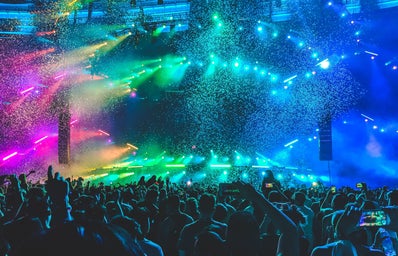The 80s and 90s were consumed by a radical youth movement:raving. Characterised as energetic, all-night dance parties, raves sparked a cultural revolution. To this day,techno music serves as a universal language that communicates unity, hedonism, and freedom.
Beginning as an underground movement, raves have evolved from illicit gatherings to highly organised, commercialised events that are found all over the world as a result of this burgeoning culture. Festivals, techno events and clubs today owe their success to this rave renaissance.
BUT WHERE DID IT ALL BEGIN?
The term “rave” gained popularity during 1950s London, generally being used to describe the “wild bohemian parties” of Soho. However, due to the dynamic nature of British popular culture, the rapid change from mods to hippies meant that the term fell out of fashion around 1967. It wasn’t until the 1980s that rave culture was predominantly recognised.Acid housemusic started to develop in Chicago as a variant of disco music, the hegemonic genre of the time. This then quickly started spreading to the UK. Manchester was one of the first cities to accommodate this music in warehouses and clubs, principally due to the Northern Soul movement. Acknowledged as the most significant step in the creation of contemporary club culture and rave scenes, Northern Soul defined the music and dance revolution and was fundamental in generating networks of clubs and DJs.
The Second Summer of Love was a 1980s phenomenon in the UK, coordinated as a reaction against Thatcherism which witnessed the rise of techno music and unlicensed raves. Not only was rave culture rapidly expanding across the nation, but it soon began to dominate the overseas underground scene of Berlin, Milan, and Amsterdam. Although many variants of the original acid house music were played, hardcore techno was commonly known by the early ravers. This genre was characterised by its high tempo and is mostly prevalent in the Netherlands today.
The musical genres continued to be fragmented and modified over the years until 1993, when there was a distinctive polarising split between techno and jungle. Techno went on to develop trance and progressive house, whereas jungle evolved into the umbrella of drum and bass, including liquid and jump-up.
However, the authorities reacted with hostility towards this rapidly expanding culture. Unauthorised gatherings were shut down and fines were issued due to growing concerns about antisocial behaviour and drug use. Despite this, rave organisers still managed to operate around restrictions by using pirate radio stations and private telephone numbers to distribute information regarding the location and time of their raves.
Tensions were rising and so were the number of illicit raves, but the rave that changed history was that of Castlemorton Common in Worcestershire, 1992. Dubbed as the biggest illegal rave in British history, this gathering of over 20,000 people resulted in a trialcosting over £4m. This ultimately led to the passing of government legislation in 1994, banning large events featuring music that was “characterised by the emission of a succession of repetitive beats”. Raves were officially illegal.
Although raves had temporarily halted, the popularity of their music did not. Techno and jungle began to permeate the charts and club scene and soon licensed raves came into fruition. Fantazia and other large business promoters started to facilitate raves acceptance into mainstream culture, along with the help from popular clubs such as Ministry of Sound in London and Hacienda in Manchester. What began as a grassroots level movement in the 1980s has since then become a global phenomenon, catalysing the development of some of the biggest record labels of today such as Solid Grooves, Defected Records, Jungle Cakes and Souped Up.
HAS THE 80S ACID RAVE CULTURE COME BACK?


